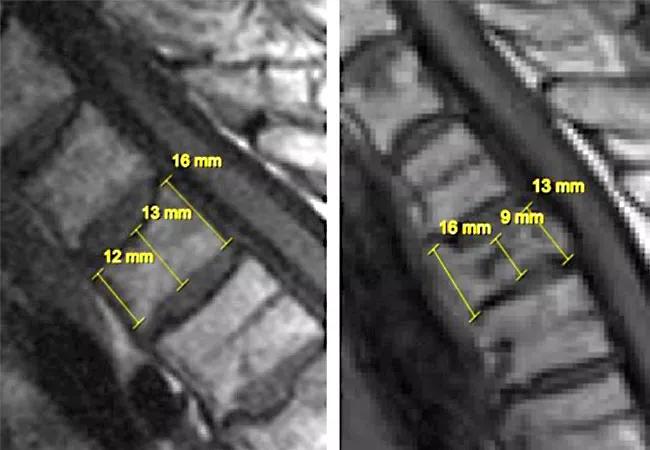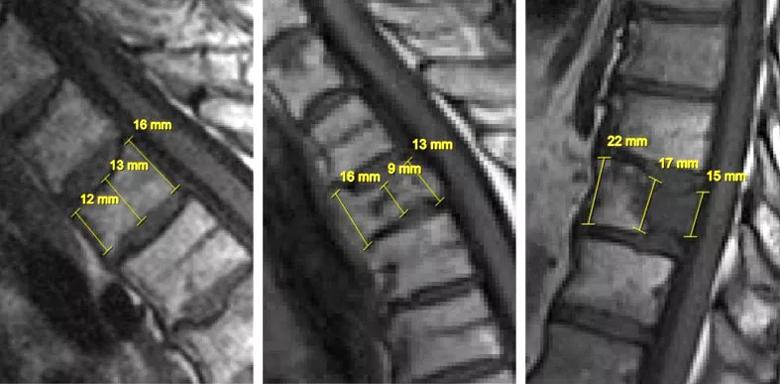Advertisement
First characterization of myeloma-related fractures’ natural progression

More than 26,000 Americans are diagnosed with multiple myeloma each year, and nearly 7 in 10 of them suffer a vertebral fracture during the course of their disease. Now a new retrospective analysis from Cleveland Clinic indicates that fractures in such patients are associated with loss of nearly 1 percent of vertebral body height per month.
Advertisement
Cleveland Clinic is a non-profit academic medical center. Advertising on our site helps support our mission. We do not endorse non-Cleveland Clinic products or services. Policy
Results of the analysis were published in two recent papers in The Spine Journal by a Cleveland Clinic research team led by spine surgeon Thomas Mroz, MD. The first paper revealed significant vertebral fracture progression in patients with multiple myeloma despite high utilization of bisphosphonates, while the second paper identified several comorbidities and lab measures that predicted rapid vertebral height loss and future fracture risk.
“Vertebral fractures are highly common in patients with multiple myeloma and significantly diminish their quality of life,” says Dr. Mroz, Co-Director of Cleveland Clinic’s Center for Spine Health. “Yet no prior studies had radiographically characterized the natural progression of fractures in this population or examined predictors of fracture progression. Our findings suggest that earlier and more aggressive surveillance and treatment of vertebral fractures in these patients may improve quality of life and protect against neurologic deterioration.”
Both Spine Journal papers stem from a retrospective analysis of consecutive patients at Cleveland Clinic who had both multiple myeloma and an associated pathologic vertebral fracture from 2007 through 2013. Anterior, middle and posterior vertebral body heights were measured from midline sagittal T1-weighted MRIs at baseline and each follow-up visit through the end of follow-up (mean of 40 months) or until surgical spine intervention or death. Fractures were characterized by Genant grade and morphology (see Figure).

Figure. Radiographic examples of vertebral fractures and measuring methodology. Left image shows a T4 mild wedge fracture with the greatest height loss along the anterior aspect. Middle image shows a T2 severe biconcave fracture with the greatest height loss along the middle aspect. Right image shows a T10 moderate crush fracture with the greatest height loss along the posterior aspect. Reprinted from Xiao et al., The Spine Journal (2015 Oct 26 [Epub ahead of print]), ©2015, with permission from Elsevier.
Thirty-three patients met the inclusion criteria over the seven-year study period; mean age was 66 ± 12 years, and 64 percent were female. Seventy percent of patients presenting with vertebral fracture did not have a prior diagnosis of multiple myeloma.
Key results included the following:
Advertisement
“These results are clinically significant because they establish a window for initiating fracture progression prophylaxis or intervention,” Dr. Mroz notes. “Since loss of vertebral body height is greatest immediately after fracture diagnosis, early referral of patients with multiple myeloma to spine specialists may be critical for evaluation and possible intervention before radiographic and symptomatic progression. This could be vital to preserving quality of life in a patient population with a 10-year survival rate of 30 percent.”
He adds that these findings suggest it may be appropriate to explore the utility of early cement augmentation in conjunction with evidence-based fracture surveillance regimens in patients with multiple myeloma. “The next phase of our analysis will be a controlled, prospective study to determine the usefulness of bracing following multiple myeloma diagnosis,” he says.
Findings from multivariate analysis of the current retrospective sample shed light on which patients with multiple myeloma may be at greatest risk for increased fracture progression and new fractures:
“We hope these findings help lead to efforts to develop evidence-based guidelines for spine surveillance and treatment in the multiple myeloma population,” Dr. Mroz observes. “Together with early referral to spine specialists, such efforts could optimize function and minimize morbidity in these patients.”
Advertisement
Advertisement

Real-world claims data and tissue culture studies set the stage for randomized clinical testing

New grant-funded investigation illustrates impact and reach of Cleveland Clinic Brain Study

How the new longitudinal investigation could become the Framingham Heart Study of brain health

Pilot findings show good patient acceptance and safety, early hints of efficacy

Study finds high prevalence of symptoms, willingness to seek treatment

Panel outlines research priorities around a promising alternative to imaging markers

Suspected factors include antithrombotic intensity, time on device, presence of thrombocytopenia

Preclinical studies will assess whether method developed for stroke recovery curbs deficits after brain injury